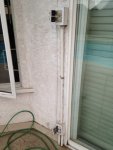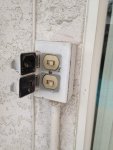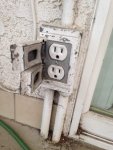My new home problems just keep multiplying.
I was on this forum reading about GFCI requirements and found out that as of 2009, it was required that pool equipment be wired directly to a GFCI breaker switch. This is true right?
In inspecting my pool equipment, I found what appeared to be adequate bonding wires, but NO GFCI breaker at the panel. My electrician installed the GFCI breaker and the thing will not turn on, because it keeps tripping. Well, we followed the line and found out a couple of things that I'm wondering about.
Should my pool equipment have its own line directly to the breaker? it currently has a GFCI outlet between it and the breaker panel. Perhaps this was the GFCI protection they intended on having?
Also, the wiring appears to be running through WHITE PVC pipes. My electrician indicated that these are PVC pipes for water use as opposed to the grey ones he uses.
Finally, the wires running through the pipe ending up in the area of my pool equipment was very sloppily connected in what looks like a tiny junction box on the floor. The problem is that the opening is facing UP to the sky, and the cover on it was totally loose that we could open it by gently touching it. Inside it were the exposed wires AND all sorts of leaves, spider webs and dirt. This can't be good right?
Is it best to just route all new dedicated lines from the breaker panel to the pool equipment? I would get all new conduit and of course, a GFCI breaker switch.
Is it best to replace the very old looking pump that still seems to leak a tiny bit at the filter flange when my filter pressure is close to 30 psi?
My electrician says that either the wiring OR the pump is causing the GFCI switch to trip.
It's gonna cost around $1500 to create the new lines, as he said he would do it correctly and hidden (he was going to dig up planters and stuff so the conduit was hidden as much as possible).
In the meantime, he suggested that I never swim in the pool unless i switch off the breaker for the pool equipment. Is this necessary?
Thanks in advance for your advice. I'm gonna be a sponsor for this site right away. You all have saved me tons of money and likely protected me and my family from problems.
I was on this forum reading about GFCI requirements and found out that as of 2009, it was required that pool equipment be wired directly to a GFCI breaker switch. This is true right?
In inspecting my pool equipment, I found what appeared to be adequate bonding wires, but NO GFCI breaker at the panel. My electrician installed the GFCI breaker and the thing will not turn on, because it keeps tripping. Well, we followed the line and found out a couple of things that I'm wondering about.
Should my pool equipment have its own line directly to the breaker? it currently has a GFCI outlet between it and the breaker panel. Perhaps this was the GFCI protection they intended on having?
Also, the wiring appears to be running through WHITE PVC pipes. My electrician indicated that these are PVC pipes for water use as opposed to the grey ones he uses.
Finally, the wires running through the pipe ending up in the area of my pool equipment was very sloppily connected in what looks like a tiny junction box on the floor. The problem is that the opening is facing UP to the sky, and the cover on it was totally loose that we could open it by gently touching it. Inside it were the exposed wires AND all sorts of leaves, spider webs and dirt. This can't be good right?
Is it best to just route all new dedicated lines from the breaker panel to the pool equipment? I would get all new conduit and of course, a GFCI breaker switch.
Is it best to replace the very old looking pump that still seems to leak a tiny bit at the filter flange when my filter pressure is close to 30 psi?
My electrician says that either the wiring OR the pump is causing the GFCI switch to trip.
It's gonna cost around $1500 to create the new lines, as he said he would do it correctly and hidden (he was going to dig up planters and stuff so the conduit was hidden as much as possible).
In the meantime, he suggested that I never swim in the pool unless i switch off the breaker for the pool equipment. Is this necessary?
Thanks in advance for your advice. I'm gonna be a sponsor for this site right away. You all have saved me tons of money and likely protected me and my family from problems.






